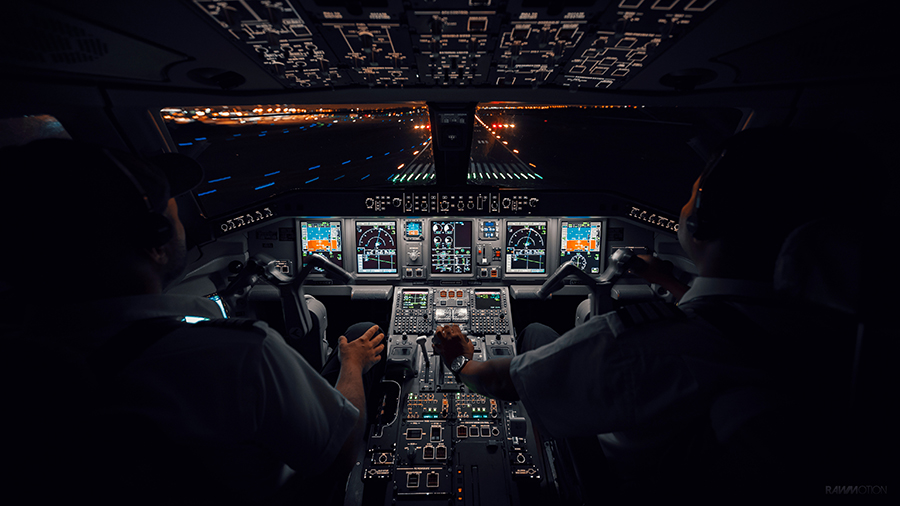As with other complex and international industries, aviation is filled with acronyms and jargon. Learning abbreviations, definitions, and slang can be intimidating, particularly for student pilots.
This article contains a glossary of the most common aviation terminology that every pilot should know, which will allow you to start “talking the talk” like the pros.
A
Absolute Ceiling: The highest altitude an aircraft can maintain while maintaining a constant airspeed.
Accelerated Stall: A stall that occurs higher than the published stall speed.
ADF (Automatic Direction Finder): A radio navigation system that identifies the relative bearing of an aircraft in relation to a non-directional radio beacon (NDB).
Adiabatic Lapse Rate: The rate of temperature change due to an increase or decrease in altitude.
Adverse Aileron Yaw: A yawing moment in the opposite direction of a turn created by aileron deflection and the subsequent difference in drag.
Aeronautical Decision-Making: The systematic approach to constantly determine the best decision in an aviation environment.
Aeronautical Information Manual (AIM): An official Federal Aviation Administration (FAA) publication that describes the correct procedures to be followed in the US.
AGL (Above Ground Level): The vertical distance between the aircraft and the ground.
Aileron: The movable, hinged flight control surfaces used to roll an aircraft.
Airfoil: The cross-sectional shape of a wing or similar surface, such as a blade, that produces lift.
Airline: A company that offers commercial flights on regularly scheduled routes.
Airspace Class: A type of airspace, defined by ICAO, with specific rules and use cases.
Alfa: (Pronounced “Alpha”) The phonetic word used to refer to the letter “A.”
Airspeed Indicator (ASI): An instrument that uses pitot-static pressure readings to indicate aircraft airspeed.
Altimeter: An instrument that measures the vertical distance between the aircraft and a fixed reference.
AMT: Aviation Maintenance Technician, i.e., an aircraft mechanic.
AME: Aviation Medical Examiner, i.e., a doctor specializing in aviation medicine.
The angle of Incidence: The angle between the chord line of an airfoil and the longitudinal axis of an aircraft.
The angle of Attack: The angle between the relative airflow and the chord line of an airfoil.
Anhedral: The downward sloping angle of a wing.
Apron: A paved area designated for aircraft parking and movement.
Approach: The phase of flight before landing.
ATIS: Automatic Terminal Information Service, a continuous broadcast of weather and operational information, usually on a VHF radio-frequency.
Avionics Master Switch: A switch that engages or disengages the electrical power for the aircraft’s avionics.
B
Blade Angle: The angle between the propeller blade’s reference line and the axis of rotation.
Bleed Air: Hot compressed air from the compressor stage of an engine.
Bravo: The phonetic word used to refer to the letter “B.”
C
Cabin Crew: The airline staff members aboard an aircraft, commonly used to refer to the flight attendants.
Calibrated Airspeed: Indicated airspeed corrected for position and instrument errors.
Camber: The curve of an airfoil.
Cargo: Items carried on board an aircraft.
Center of Gravity (CG): The point at which weight is evenly dispersed. In other words, the points through which the force of gravity effectively acts.
Charter: An aircraft that is rented out as a whole in contrast to a commercial flight where each seat is sold individually.
Charlie: The phonetic word used to refer to the letter “C.”
Chord Line: A figurative straight line that runs between an airfoil’s leading and trailing edges.
Climb: And increase in aircraft altitude.
Cockpit: Also known as the flight deck, this area of the aircraft contains the avionics and controls used by the pilots.
C of A: Refers to theCertificate of Airworthiness, a document akin to a car’s registration document.
Common Traffic Advisory Frequency (CTAF): A radio frequency used for communication between aircraft at non-towered airports or outside of operating hours.
Constant-Speed Propeller: A propellor system designed to maintain a constant RPM by automatically varying the blade pitch.
Contrail: A white streak behind an aircraft caused by the rapid condensation of water vapor from an aircraft’s jet stream.
Course Deviation Indicator (CDI): An instrument used to indicate lateral course deviation.
Controlled Airspace: Designated airspace managed by Air Traffic Control (ATC) services.
Cross-Country: A term generally used in the context of flight training; a cross-country flight is a flight away from the departure airport.
Crosswind: A wind blowing perpendicular (i.e., from left to right or vice versa) to the aircraft’s track.
D
Delta: The phonetic word used to refer to the letter “D.”
Density Altitude (DA): A measure of air density expressed as an altitude above Mean Sea Level (MSL).
Descent: The process of decreasing an aircraft’s altitude.
Distance Measuring Equipment (DME): Equipment used to measure the slant distance between an aircraft and a ground station.
Dogfight: A short-range aerial battle between aircraft, often involving sharp maneuvers.
Drag: A force that opposes an aircraft’s movement through the air.
Downwind Leg: A track parallel to and in the opposite direction of the runway intended for landing.
E
EASA (European Aviation Safety Agency): The European equivalent of the FAA (Federal Aviation Administration).
Echo: The phonetic word used to refer to the letter “E.”
Empennage: The tail of an aircraft, usually consisting of a vertical and horizontal stabilizer.
Elevator: A horizontal surface that is used to control the aircraft in pitch.
Estimated Time of Arrival (ETA): The approximate time that you will arrive at a destination.
Estimated Time of Departure (ETD): The approximate time that you intend to depart your destination.
Estimated Time en Route (ETE): The approximate amount of time spent traveling between two points.
F
Federal Aviation Administration (FAA): A transportation agency regulating civil aviation in the United States.
Federal Aviation Regulations (FARs): The legislation governing civil aviation in the U.S.
Fixed-Base Operator (FBO): A company that provides aviation services such as fuel, parking, and hangar space at an airport.
Feathering: The act of reducing a propeller blade’s pitch angle.
Ferry Flight: A flight intended to reposition an aircraft to a different airport.
Final Approach: The final phase of flight before landing.
Firewall: A fire-resistant barrier between the aircraft engine and its surrounding areas.
Five by Five: A phrase used to indicate that a radio transmission is clear on a scale from 1 to 5.
Flaps: Devices, typically located on the trailing edges of a wing, that are used to increase lift at lower airspeeds.
Flare: The final maneuver before an aircraft touches down where the nose is pointed upwards, and the descent rate is reduced.
Flight Bag: Used to carry useful documents and tools, such as headsets or checklists.
Flight Computer: A device, similar to a calculator, used to perform aviation calculations such as fuel consumption, speed, or wind direction.
Flight Deck: Also known as the cockpit, this area of the aircraft contains the avionics and flight controls used by the pilots.
Flight Plan: A document following a specific format, which includes information about a particular flight, such as the destination or aircraft type.
First Officer (F/O): The Second in Command (SIC) of the aircraft, also known as the copilot.
Fog: A thick cloud at or near the Earth’s surface.
Foxtrot: The phonetic word used to refer to the letter “F.”
Flight Standards District Office (FSDO): A local field office affiliated with the Federal Aviation Administration (FAA).
Fuselage: The central structure of the aircraft, intended for the flight crew, passengers, and cargo.
G
General Aviation: All civil aviation aircraft operations with the exception of commercial operations.
Glass Cockpit: Electronic, digital instrument displays, in contrast to analog-style gauges.
Go-Around: The process by which a landing attempt is abandoned.
Golf: The phonetic word used to refer to the letter “G.”
Gross Weight: The total weight of an aircraft.
Ground Effect: A decrease in drag that occurs when an aircraft flies close to the ground.
Groundspeed: The horizontal speed of an aircraft relative to the ground directly below.
H
Handoff: The transferring of radar identification and radio communication of an aircraft from one controller to another.
Handshake: The initial greeting between two computers when a connection is established.
Hangar: A building used to store aircraft, typically located at an airport.
Heavy: A radiotelephony term for a large aircraft with a maximum take of weight of 136 tonnes (300,000 lb) or more.
Horizontal Stabilizer: The horizontal surface located at the back of the aircraft.
Hotel: The phonetic word used to refer to the letter “H.”
Hypoxia: A condition caused by a lack of oxygen, posing a particular danger at high altitudes.
I
ICAO (International Civil Aviation Organization): An agency of the United Nations created to promote international civil aviation’s safe and orderly development.
Instrument Landing System (ILS): A ground-based system that utilizes radio waves to guide an aircraft to a runway.
Instrument Flight Rules (IFR): The set of rules that govern flight with no outside visual reference.
India: The phonetic word used to refer to the letter “I.”
Indicated Airspeed (IAS): The speed of an aircraft as displayed on an airspeed indicator.
Instrument Metrological Conditions (IMC): Weather conditions that require pilots to fly by sole reference to instruments, such as cloud, fog, or rain.
J
Jet: An aircraft propelled by one or more jet engines.
Joystick: Also known as a flight stick, a joystick is an input device consisting of a vertical stick that pivots from a base.
Juliet: The phonetic word used to refer to the letter “J.”
K
Calibrated Airspeed in Knots (KCAS): Indicated a speed corrected for instrument and position errors.
Indicated Airspeed in Knots (KIAS): Airspeed as indicated by the airspeed indicator.
Kneeboard: A small clipboard that is attached to the thigh.
Knot: 1 knot = 1 nautical mile per hour.
True Airspeed in Knots (KTAS): The airspeed of an aircraft relative to the air mass it is flying through.
Kilo: The phonetic word used to refer to the letter “K.”
L
Laminar Flow: The smooth airflow over an aircraft’s wing.
Lift: A force acting perpendicular to the oncoming airflow, and opposing weight.
Lima: The phonetic word used to refer to the letter “L.”
Load Factor: Also known as g-force, the load factor is the ratio of the lift produced by an aircraft compared to its weight.
Longitudinal Axis: A horizontal direction from the aircraft’s nose to its tail.
M
Mach: The ratio of an aircraft’s speed to the speed of sound.
Magnetic Compass: An instrument that displays direction on the surface of the Earth through a magnetic pointer that is aligned with the Earth’s magnetic field.
Magnetic Deviation: A magnetic compass error induced by local magnetic fields of aircraft materials.
Magnetic North: The location is indicated as north on a magnetic compass, in contrast to true (geographical) north.
Magneto: An isolated component of the engine ignition system that provides high voltage electricity to the spark plugs.
Mean Sea Level (MSL): The average level of the ocean’s surface.
METeorological Aerodrome Report (METAR): A standard format for reporting weather information.
Morse Code: A method of representing letters of the alphabet and numbers by an arrangement of dots, dashes, and spaces.
Maximum Take-Off Weight (MTOW): The maximum weight allowed for takeoff.Mike: The phonetic word used to refer to the letter “M.”
N
Narrow-Body Aircraft: A smaller aircraft with only one aisle inside the cabin.
Non-Directional Beacon (NDB): A low-frequency ground-based navigation aid.
Notice to Airmen (NOTAM): A notice filed to alert pilots of possible hazards or non-standard procedures along a particular route or location.
November: The phonetic word used to refer to the letter “N.”
O
Outside Air Temperature (OAT): The temperature of the air around an aircraft that is unaffected by the aircraft itself.
Operating Limitations: Restrictions to certain operations as defined by the aircraft manufacturer, such as airspeed, weight, or altitude.
Oscar: The phonetic word used to refer to the letter “O.”
P
Payload: The content carried by aircraft, excluding what is necessary for operation.
Papa: The phonetic word used to refer to the letter “P.”
Pilot in Command (PIC): Also known as the captain, the Pilot in Command is the pilot responsible for the aircraft operation and the ultimate authority on board.
Pilot Report (PIREP): Weather reports made by pilots to Air Traffic Control (ATC).
Pitch: The tilting of the aircraft up or down, i.e., the nose and tail rising and falling.
Pitot Tube: A small tube situated parallel to the airflow is used to measure air pressure.
Pilot’s Operating Handbook (POH): The aircraft flight manual.
Primary Flight Display (PFD): The primary avionics screen used by the pilots.
Propeller: A rotating blade that creates thrust by displacing air.
Q
Quadruplane: An aircraft with four wings.
Quick Access Recorder (QAR): A flight data recorder intended to provide easy access to raw flight data.
Quebec: The phonetic word used to refer to the letter “Q.”
R
Roll: The rotation of an aircraft about the longitudinal axis, running from the nose to the tail.
Rudder: A control surface, usually attached to the vertical stabilizer, used to control the aircraft in yaw.
Runway (RWY): A straight rectangular area used by aircraft for landing and takeoff.
Runway End Safety Area (RESA): A designated area beyond the end of a runway designed to be used in an emergency to stop an aircraft from overshooting.
Romeo: The phonetic word used to refer to the letter “R.”
S
Short Field: A runway that is shorter in length than average.
Sideslip: The sideward movement of an aircraft in relation to the wind.
Skid: The sliding outward movement of an aircraft during a turn.
Slip: The sliding inward movement of an aircraft during a turn.
Squawk: A four-digit code provided by Air Traffic Control to be inputted into a transponder for aircraft identification.
Stall: A condition that causes a significant decrease in lift due to the aircraft exceeding the critical angle of attack.
Standard Rate of Turn (also known as a Rate 1 turn): A rate of turn of 3° per second (360° in two minutes).
Straight and Level: Flight at a constant altitude and heading.
Sierra: The phonetic word used to refer to the letter “S.”
T
Tail: The rear section of an aircraft.
Threshold: The first section of a runway designated with specific markings.
Throttle: A control in the cockpit is used to control the output of the engine.
Thrust: The force created by the engine(s) which opposes drag.
Torque: Rotational force.
Touch and Go: The act of landing and then taking off from a runway without stopping.
Transponder: A piece of equipment on an aircraft that outputs signals used by ATC for identification purposes.
Trim Tab: A small surface on the edge of a control surface intended to counteract aerodynamic forces on the control surface.
True Airspeed (TAS): The airspeed of the aircraft corrected for errors caused by altitude and temperature.
Turbulence: An abrupt change in airflow caused by atmospheric conditions.
Tower (TWR): A tall building where air traffic controllers work, providing optimal views of the airport.
Taxiway (TWY): The area of an airport used by aircraft to navigate to a runway or apron.
Tango: The phonetic word used to refer to the letter “T.”
U
Upwind Leg: A flight path that runs parallel to the runway in the same direction of takeoff.
Useful Load: The content carried by aircraft in addition to its own weight, such as the pilots, passengers, and feel.
Universal Time Coordinated (UTC): The standard used for time zones worldwide.Uniform: The phonetic word used to refer to the letter “U.”
V
V speed: A standard term used to describe specific airspeeds, such as Vne (never exceed speed).
Vertical Speed Indicator (VSI): An instrument that indicates the rate of climb or descent.
Very High Frequency (VHF) Omni-Directional Range (VOR): A ground-based navigation aid used by aircraft to receive 360-degree directional information.
Visual Flight Rules (VFR): Regulations that define aircraft operations using visual references.
VFR On Top: VFR conditions above a cloud layer.
Visual Metrological Conditions (VMC): Weather conditions that allow pilots to operate according to visual references.
Victor: The phonetic word used to refer to the letter “V.”
W
Wide Body Aircraft: An aircraft with at least two aisles inside.
Windshear: An abrupt change in horizontal and/or vertical wind direction.
Wx: An abbreviation for “weather.”
Whiskey: The phonetic word used to refer to the letter “W.”
X
XC: An abbreviation for “cross-country.”
X-Ray: The phonetic word used to refer to the letter “X.”
Y
Yaw: The rotation of the aircraft around its vertical axis.
Yoke: Also known as a control column, the yoke is used to move the control surfaces of the aircraft.
Yankee: The phonetic word used to refer to the letter “Y.”
Zulu Time: The standard time zone used throughout the aviation and synonymous with UTC (Universal Coordinated Time).
Zulu: The phonetic word used to refer to the letter “Z.”
Conclusion
Well done, you got to the end – you now know nearly every word in the aviation world! Keep this page bookmarked for the next time you hear a word that sounds familiar but you can’t quite remember.



